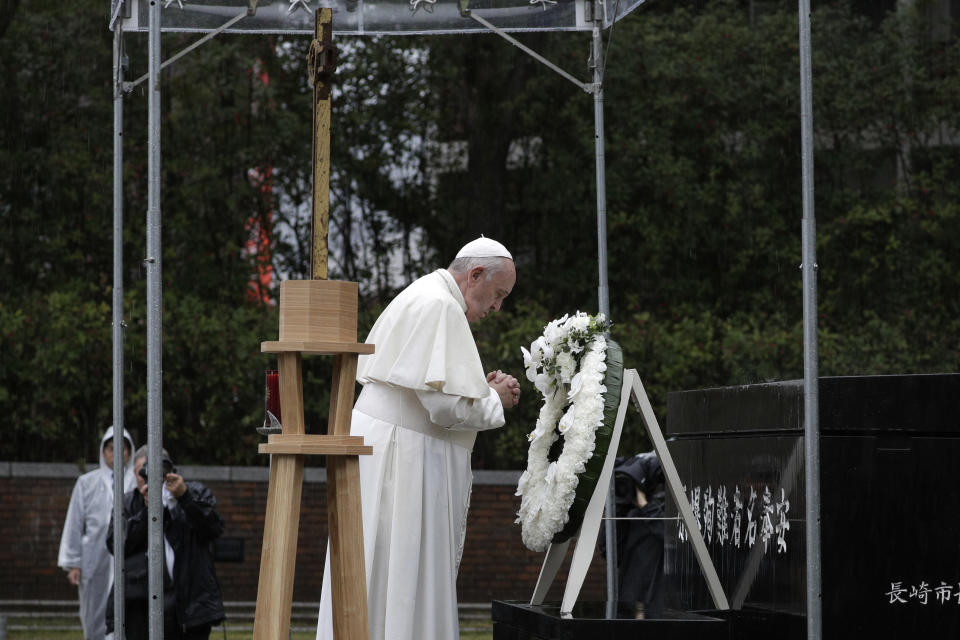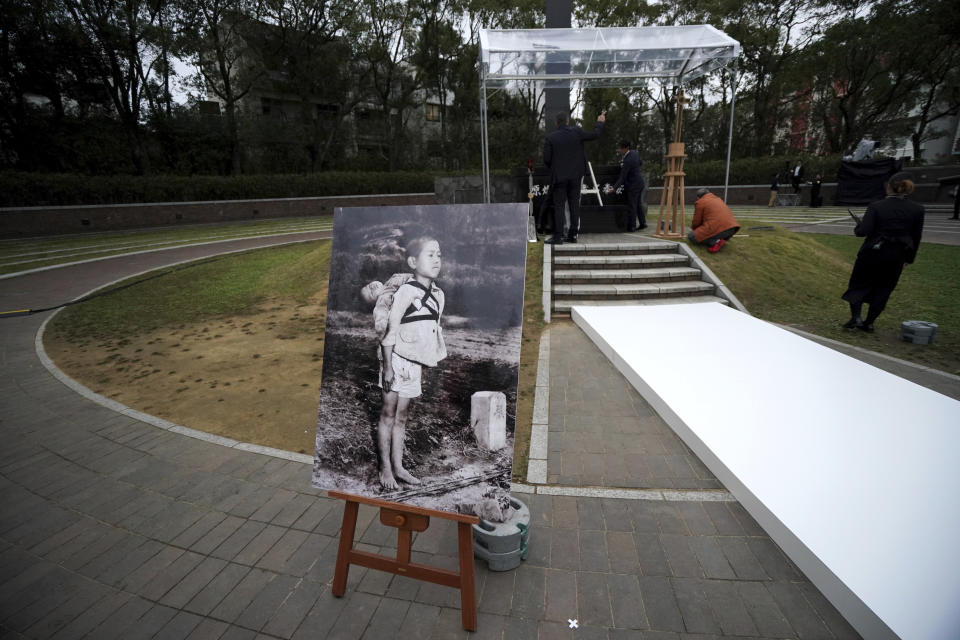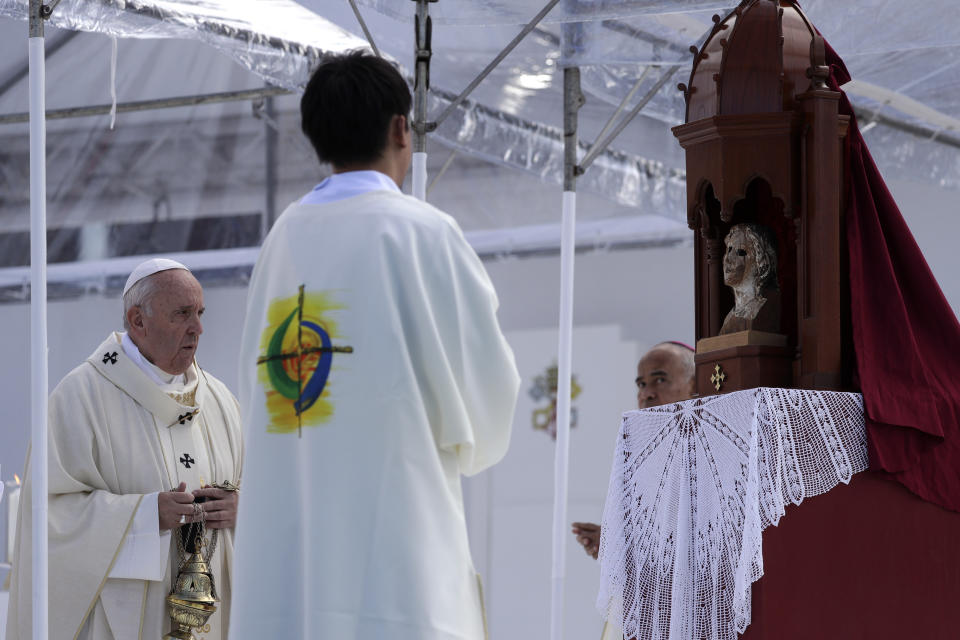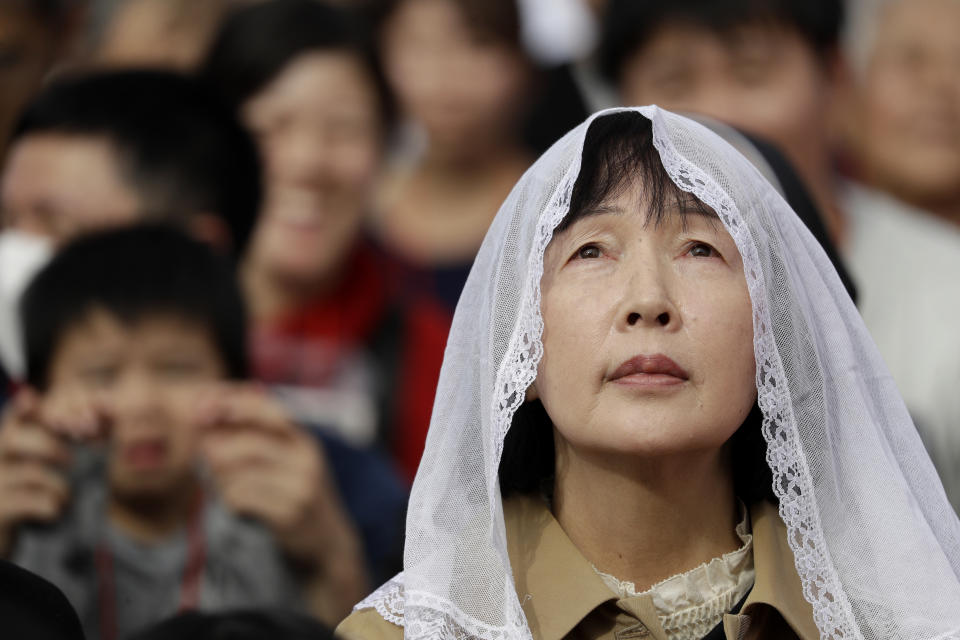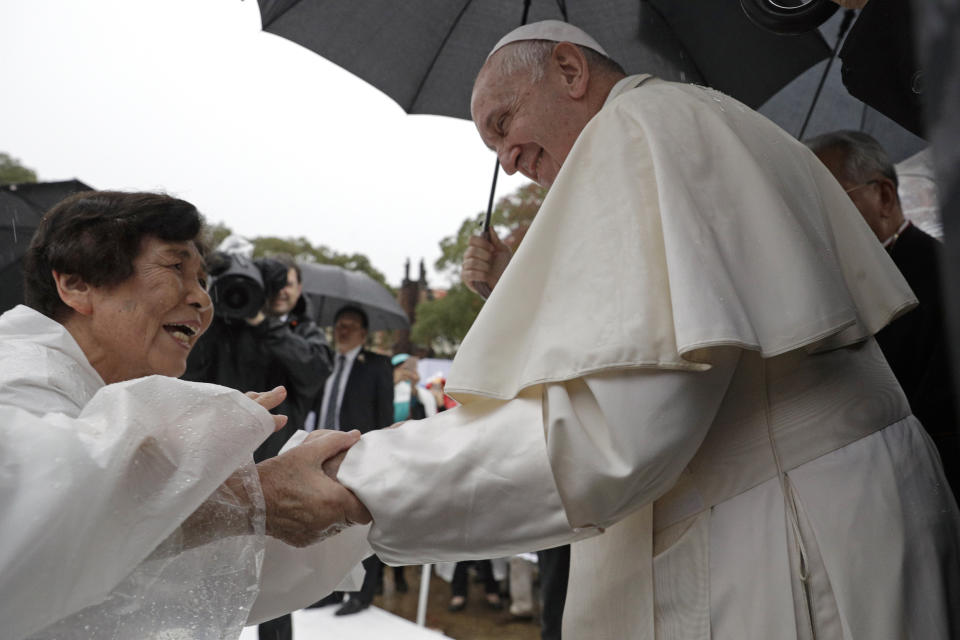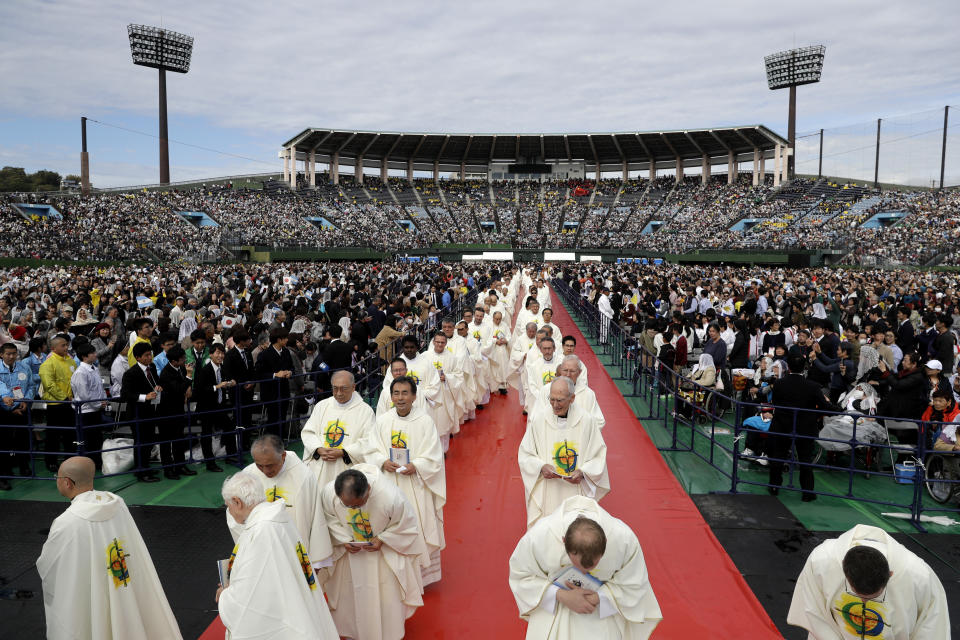The Latest: Pope’s message resonates with students
HIROSHIMA, Japan (AP) — The Latest on the pope’s visit to Japan (all times local):
10:50 p.m.
Pope Francis’ powerful message of peace and a world free of nuclear weapons that he brought to the two cities to have suffered atomic attacks has struck a chord with the younger generation.
Francis visited Nagasaki and Hiroshima on Sunday to demand world powers renounce their nuclear arsenals, declaring the use and possession of atomic bombs an “immoral” crime and a dangerous waste.
A Hiroshima high school student, 17-year-old Nozomi Kitahata, said the pope’s visit prompted her to renew “my resolve to work toward peace.”
She was among a group of high school students who joined the pope and survivors of the 1945 U.S. atomic bombings at Hiroshima Peace Memorial Park.
Koharu Matsuda, also 17, said she could see the pope’s understanding and compassion for the atomic bombing survivors, and that “I can imagine how much his visit meant to the survivors.”
___
9:55 p.m.
A survivor of the Hiroshima atomic bombing has shaken hands with Pope Francis, who gently placed his hand on her head for a blessing.
Yoshiko Kajimoto, who developed stomach cancer and leukemia due to radiation from the Aug. 6, 1945, U.S. bombing, which killed her parents, said a 2-minute speech delivered before the pope in Hiroshima on Sunday was too short to tell her entire story.
But after meeting Francis, she said she’s confident he got her message and will push for a nuclear-free world when he meets Prime Minister Shinzo Abe on Monday.
Kajimoto is among many bombing survivors who has expressed frustration with the refusal by Japan, which is under the U.S. nuclear umbrella, to sign the nuclear weapons ban treaty.
___
8:15 p.m.
Pope Francis has declared the possession of nuclear weapons "immoral," going beyond his predecessors to condemn the Cold War-era doctrine of deterrence and demand a complete ban on atomic bombs.
Francis made the comments while standing at the peace memorial in Hiroshima on Sunday, at the end of a day in which he paid homage to victims of the U.S. atomic bombings there and in Nagasaki. It was the first full day of his three-day visit to Japan.
Francis deviated from his prepared text, which declared only that the use of atomic weapons for war was immoral. He added that "The possession of weapons is also immoral." Francis first condemned the possession of nuclear weapons in 2017.
___
5:50 p.m.
Pope Francis rode in a carbon-free popemobile at his Mass in Nagasaki, an appropriate choice in line with his environmental concerns.
Organizers say Francis used a Toyota hydrogen-powered Mirai, customized with a stand and handrails. He will use a similar model while in Tokyo.
The pope held a big Mass at a Nagasaki city baseball stadium. Earlier Sunday, he demanded world leaders renounce atomic weapons and the Cold War-era doctrine of deterrence, and paid respects at a memorial for the 26 martyrs.
Environmental protection is one of Francis' key agenda items and is also part of the theme of his Japan visit.
___
3 p.m.
The son of the U.S. Marine photographer who filmed a boy carrying his dead brother in the aftermath of the atomic bombing of Nagasaki has shaken hands with Pope Francis.
Francis visited the Nagasaki ground zero Sunday and demanded world leaders renounce atomic weapons and the Cold War-era doctrine of deterrence.
Tyge O’Donnel, the son of Joseph O’Donnell, was invited to the event as a guest. His father’s iconic photo was printed on cards that Francis delivered in 2017 in his anti-nuclear message.
O’Donnell, his camera hanging from the neck, approached Francis as the pope was greeting people after the speech. O’Donnell described the encounter as a “phenomenal experience.”
He says the pope’s eyes were “very very kind and he was well spoken. I was just amazed. I am very pleased to have met him.”
___
2:45 p.m.
Pope Francis is celebrating Mass in Nagasaki before an estimated 35,000 people — and the remains of a wooden statue of the Virgin Mary rescued from a cathedral destroyed in the 1945 atomic bomb.
The statue, which was remarkably well preserved despite the blast, was featured on the altar during Francis’ Mass on Sunday.
In his homily, Francis recalled both the victims of the atomic bombing, and the thousands of Christians killed for their faith during two centuries of persecution.
He says: “We want to follow in their path, to walk in their footsteps and to profess courageously that the love poured out in sacrifice for us by Christ crucified is capable of overcoming all manner of hatred, selfishness, mockery and evasion.”
___
2 p.m.
Nagasaki Mayor Tomihisa Taue says Pope Francis’ visit and condemnation of nuclear weapons at the site of the atomic bombing that devastated the Japanese city at the end of World War II is a powerful message.
Francis arrived first in Nagasaki on Sunday to pray for the victims of the American bombing, three days after the first A-bomb hit Hiroshima, where he is also visiting later Sunday.
Francis demanded world leaders renounce atomic weapons and the Cold War-era doctrine of deterrence.
Taue says the pope delivered a message that “reminded us of the most important and basic concept to achieve a world without nuclear weapons.”
The atomic bomb attack on Nagasaki on Aug. 9, 1945, killed 74,000 people. The earlier bombing of Hiroshima killed 140,000.
___
10:45 a.m.
Is the pope “Kyoko,” or “Ho-o” in Japanese?
The Japanese government adopted the term “Kyoko” as the official translation of his title ahead of his visit this weekend, in line with the policy of the Catholic Church in Japan.
Catholics also used both titles but adopted the new title “Kyoko” following the 1981 visit to Japan by St. John Paul II. The faithful say it includes the Chinese character that clearly shows that the pope is a man of teachings. The Chinese characters used in the new title literally mean “emperor of teachings.” The earlier one meant “king of law.”
The official translation of the pope had been “Ho-o” in Japanese dating from when the Vatican established ties with Japan in 1942. That name remains on a plate posted at the Vatican’s embassy entrance.
Many Catholics actually call the pope “Kyoko-sama,” or “Kyoko-san.” Phonetically, “Kyoko” is also a common name for Japanese women.
___
10:10 a.m.
Pope Francis is bringing his peace message to Nagasaki and Hiroshima on his first full day in Japan, paying homage to the victims of the U.S. atomic bombings and demanding an end to the stockpiling and use of nuclear weapons.
Francis was arriving first in Nagasaki as a downpour Sunday drenched the terraced fields and rice paddies around town, where autumn has begun turning hills of green into shades of red, yellow and orange.
Japanese Catholics and others are braving the rain in plastic raincoats, some queuing up for hours to secure a spot for Francis’ Mass in the baseball stadium. Others gathered at the outdoor memorial to bombing victims at ground zero, where Francis was expected to deliver a strong appeal for complete nuclear disarmament.
